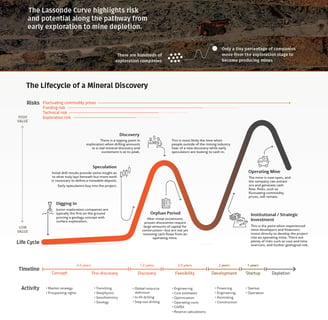Providing support for the precious metals and critical minerals junior mining sectors
Host Rock Capital Advisory SL (“Host Rock Capital”), is an independent capital markets advisory firm catering to the metals and mining sector. We provide expert services to high-growth public and private mineral exploration and development companies and publish metals and mining financial and technical information.
We specialize in the precious metals and energy transition metals sectors (gold, silver, palladium, platinum, copper, nickel, cobalt, lithium, uranium), all of which play important roles in the global economy.
Our strength lies in our metals and mining technical and capital markets knowledge and expertise, and our relationships with industry stakeholders across the North American, European, and Australian markets.
Metals & Mining
Capital Markets Advisory
Tailored services for high-growth junior mining companies.
In-depth insights and publications on metals and mining trends.
Assisting investors and industry professionals navigate these turbulent sectors
Market Analysis
Guidance on Precious Metals and Critical Minerals Sectors
Our Peer Table aims to be a global benchmark for junior mining peer group valuations in the precious metals and critical minerals sectors.
Host Rock’s leading publication is our Metals Mining Rundown and Peer Table, which we use for our own internal and client informational needs, and also make available via subscription to our fellow investors and industry professionals across the globe.
The Metals Mining Rundown (“Rundown”) provides summary updates on:
Recent movements in metal prices (provided with both Free and Premium Subscription options)
Recent movements in peer group median equity valuations (provided with both Free and Premium Subscription options), which with a Premium Subscription are detailed in an attached Peer Table.
Coverage of company announcements affecting our Peer Table (provided with both Free and Premium Subscription options), which with a Premium Subscription is attached.
The Peer Table provides a comprehensive summary of publicly available pricing and valuation information covering 9 important metals and more than 450 metals mining stocks listed globally, including more than 150 developer stocks. The stocks are categorized into 30 different peer groups, according to company stage (resource-stage exploration, development, or production) and metal exposure (gold, silver, platinum, palladium, copper, nickel, cobalt, lithium, and uranium) for the 9 important metals we cover, which are susceptible to future global scarcity shortages due to rising consumption/demand and the important roles these minerals play in the global economy. The Peer Table is used by Host rock and its clients/subscribers for a variety of informational applications, including monitoring/ comparing relative market sentiment/valuations across the nine major metals and mining sectors we cover, and also for identifying and tracking junior mining stocks within their respective peer group valuation pecking orders (ranked according to market cap per unit resource and according to P/NAV [price-to-net-asset-value] for developers).
450+
150+
Developer Stocks
Metals Mining Stocks
Sneak peek of our leading publication
9
Important Metals
Including
30
Categorized into
Peer Groups
More than
Our Team
Our experienced team of mining and capital markets professionals have worked with numerous exploration/development companies and financial institutions stretching from North-America to Europe to Australia. With a diverse set of skills covering finance, engineering, geology, environmental science, and regulatory permitting, our team is here to keep industry participants informed on the pulse of the metals & mining markets, and to assist junior mining companies in finding the right mineral exploration and development solutions to attract the right investors and ensure long term value is being created.
Mitchell Vanderydt, P.Eng, MBA
Mr. Vanderydt has 16 years' experience in metals and mining and capital markets, including more than 10 years as a mining engineer, nearly 3 years as a mining analyst at a Toronto investment bank, and nearly 3 years in corporate leadership at a junior gold mining company in Sweden and Finland through its IPO and doubling of its mineral resources to 1Moz. He holds a Bachelor of Engineering Science from Western University in London, Canada, a Master of Business Administration from Schulich School of Business (York University) in Toronto, and a P.Eng. licence in Ontario, Canada.
Johann Boy
Adriana Boy
Founder and CEO
Associate, Mining Research and Sales
Company Secretary


Johann brings 13 years of experience in the areas of web design, IT infrastructure, and equity research. He is driven, results-focused, and detail-oriented with strong leadership attributes, demonstrated through his past entrepreneurial endeavours including operating a consultancy for several years in Guatemala City.
Adriana has 15 years of diverse experience, honed through roles that include Administrative Assistant to the Chief Executive Officer, Digital Media & Social Media Coordinator, and independent graphics designer. With a strong foundation in administration, project management, and customer service, she possesses excellent organizational, communication, and interpersonal skills that enable effective collaboration and client interaction.




BACKGROUND INFORMATION ON THE PRECIOUS METALS AND CRITICAL MINERALS JUNIOR MINING SECTORS


The junior metals mining sector (mineral exploration and development companies) aims to discover and grow mineral resources, and advance projects towards development and commercial production in order to help meet future metals demand requirements. And this exploration and development process requires significant investment to do so, which creates the opportunity for individual investors to gain exposure to these important metals for which consumption is generally rising - in many instances, quite sharply.
Key sources of metal consumption/demand for each of the nine metals that we cover include:
Precious Metals:
Gold: As an investment or store of value held by central banks and investors as bars, coins and jewelry to help shield them from devaluation of fiat currencies. Some minor industrial/technology applications.
Silver: Industrial applications including for electrical connections in solar panels, EVs, and semiconductors, with additional significant application as an investment/store of value in bars/coins/jewellery (as a substitute for gold).
Platinum Group Metals:
Palladium: Industrial applications, largely for automotive catalytic converters but also for electronics and emerging hydrogen applications, with some minor use as investment/store of value use as bars/coins/jewelry (as a substitute for gold).
Platinum: Some industrial applications, including for automotive catalytic converters in diesel-powered vehicles and also in chemical and petroleum refining and for medical applications in pacemakers and implants, with some use (more than for palladium) as an investment/store of wealth as bars/coins/jewellery (as a substitute for gold).
Base Metals:
Copper: Industrial application, largely as electrical wiring, including in EVs which use significantly more wiring than internal combustion engine vehicles, with some additional construction applications.
Nickel: Industrial application, largely as key component in stainless steel, and emerging as key battery metal in EVs.
Cobalt: Industrial applications, largely as a key battery metal in EVs.
Energy Metals:
Lithium: Industrial applications, largely as a key battery metal in EVs.
Uranium: Energy applications, as uranium oxide nuclear fuel for nuclear power generation.
Critical minerals are generally considered to be those metals and minerals deemed by a nation’s government to be important for emerging technologies, economic development, and national security, and are sometimes also prone to supply chain or scarcity challenges. It is therefore important for nations to maintain domestic or friendly supplies of these minerals, to comfortably meet the future consumption requirements of their citizens. The legal definition of “critical minerals” by various governments helps them pave the way for various forms support and incentives for the critical minerals supply chain, including at its upstream end (the junior mining sector) where bottlenecks often occur due to the decade-long-or-more time frame it takes to bring new mineral discoveries through permitting and development to commercial production. And this is especially true for those mineral deposits in the mining-friendly western world (parts of Canada, US, Latin America, Australia, and Europe) which often required increasingly extensive research and study in the areas of environmental and socioeconomic impacts and mitigation, prior to new mine construction.
Critical minerals lists range in length from roughly 20 to 50 different minerals, depending on the nation and how they are defined. The nine metals we cover are some of the most significant critical minerals (due to large and/growing market sizes) and are included on the critical minerals lists of several major governments, as shown in Table 1.
Figure 1: Visualizing the lifecycle of a mineral discovery made by a junior mining company
Source: Pierre Lassonde, Visual Capitalist
Table 1: Critical minerals status of Host Rock’s nine metals under coverage according to various major governments
Note: Information retrieved on 28 November 2024




